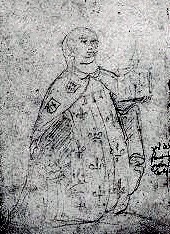Mahaut, Countess of Artois
You can help expand this article with text translated from the corresponding article in French. (July 2015) Click [show] for important translation instructions.
|
Mahaut, Countess of Artois | |
|---|---|
| suo jure Countess of Artois | |
 | |
| Born | 1268 France |
| Died | 28 October 1329 Paris, France |
| Noble family | House of Artois |
| Spouse(s) | Otto IV, Count of Burgundy |
| Issue | |
| Father | Robert II, Count of Artois |
| Mother | Amicie de Courtenay |

Mahaut, Countess of Artois (1268 – October 28, 1329, Paris), also known as Mathilda, was the eldest child (and only daughter) of Robert II, Count of Artois, and Amicie de Courtenay.
Family
Her paternal grandparents were Robert I, Count of Artois, and Matilda of Brabant. Her maternal grandparents were Pierre de Courtenay, Seigneur de Conches, and Perronelle de Joigny.[1]
Her younger brothers were:
- Philip of Artois (1269–1298). Married Blanche de Dreux, daughter of John II, Duke of Brittany, by whom he had five children.
- Robert of Artois (born 1271). Died young.
Marriage and issue
In 1291,[1] Mahaut married Otho IV, Count of Burgundy,[2] to whom she bore three children, including two girls who married kings of France:
- Joan II, Countess of Burgundy (1292-1330), married Philip V of France[3]
- Blanche of Burgundy (1296 ? – 1326), married Charles IV of France[3]
- Robert, Count of Burgundy (1300–1315).
Mahaut's daughters Joan II and Blanche, along with their cousin Margaret of Burgundy, were implicated in the Tour de Nesle Affair.
Dispute over the County of Artois

Because of the premature death of her brother Philip in 1298, she inherited the County of Artois at her father's death in 1302, rather than her nephew Robert III (her inheritance being based upon proximity of blood). Although he repeatedly challenged the decision, her rights to the county were consistently upheld by the Parlement of Paris and the royal court.[4] She was an able administrator and managed to defeat the many rebellions perpetrated by members of the nobility. Her senior administrator was the Bishop of the Roman Catholic Diocese of Arras, Thierry de Hérisson.[5] Upon her death in 1329, the county was inherited by her daughter Joan II, Countess of Burgundy (d. 1329), the widow of Philip V of France.
In fiction
Mahaut is a major character in Les Rois maudits (The Accursed Kings), a series of historical novels by Maurice Druon. Druon describes her as the poisoner of Louis X and his infant son Jean I, who is later poisoned herself the same way by her lady-in-waiting Béatrice d'Hirson, who originally helped with the King's poisoning. Allan Massie wrote in The Wall Street Journal, "Few figures in literature are as terrible as the Countess Mahaut, murderer and maker of kings."[6] She was portrayed by Hélène Duc in the 1972 French miniseries adaptation of the novels,[7] and by Jeanne Moreau in the 2005 remake.[8][9]
Ancestry
| Family of Mahaut, Countess of Artois | ||||||||||||||||||||||||||||||||||||||||||||||||||||||||||||||||||||||||||||||||||||||||||||||||||||||||||||||||||||||||||||||||||||||||||||||||||||||||||||||||||||||||||||||||||||||||||||||||||||||||||||||||||||||||||||||||||||||||||||||||||||||||||||||||||||||||||||||||||||||||||||||||||||||||||||||||||||||||||||||||||||||||||||||||||||||||||||||||||||||||||||||||||||||||||||||||||||||||||||||||||||||||||||||||||||||||||||||||||||||||||||||||||||||||||||||||||||||||||||||||||||||||||||||||||||||||||||||||||||||||||||||||||||||||||||||||||||||||||||||||||||||||||||||||||||||||||||||||
|---|---|---|---|---|---|---|---|---|---|---|---|---|---|---|---|---|---|---|---|---|---|---|---|---|---|---|---|---|---|---|---|---|---|---|---|---|---|---|---|---|---|---|---|---|---|---|---|---|---|---|---|---|---|---|---|---|---|---|---|---|---|---|---|---|---|---|---|---|---|---|---|---|---|---|---|---|---|---|---|---|---|---|---|---|---|---|---|---|---|---|---|---|---|---|---|---|---|---|---|---|---|---|---|---|---|---|---|---|---|---|---|---|---|---|---|---|---|---|---|---|---|---|---|---|---|---|---|---|---|---|---|---|---|---|---|---|---|---|---|---|---|---|---|---|---|---|---|---|---|---|---|---|---|---|---|---|---|---|---|---|---|---|---|---|---|---|---|---|---|---|---|---|---|---|---|---|---|---|---|---|---|---|---|---|---|---|---|---|---|---|---|---|---|---|---|---|---|---|---|---|---|---|---|---|---|---|---|---|---|---|---|---|---|---|---|---|---|---|---|---|---|---|---|---|---|---|---|---|---|---|---|---|---|---|---|---|---|---|---|---|---|---|---|---|---|---|---|---|---|---|---|---|---|---|---|---|---|---|---|---|---|---|---|---|---|---|---|---|---|---|---|---|---|---|---|---|---|---|---|---|---|---|---|---|---|---|---|---|---|---|---|---|---|---|---|---|---|---|---|---|---|---|---|---|---|---|---|---|---|---|---|---|---|---|---|---|---|---|---|---|---|---|---|---|---|---|---|---|---|---|---|---|---|---|---|---|---|---|---|---|---|---|---|---|---|---|---|---|---|---|---|---|---|---|---|---|---|---|---|---|---|---|---|---|---|---|---|---|---|---|---|---|---|---|---|---|---|---|---|---|---|---|---|---|---|---|---|---|---|---|---|---|---|---|---|---|---|---|---|---|---|---|---|---|---|---|---|---|---|---|---|---|---|---|---|---|---|---|---|---|---|---|---|---|---|---|---|---|---|---|---|---|---|---|---|---|---|---|---|---|---|---|---|---|---|---|---|---|---|---|---|---|---|---|---|---|---|---|---|---|---|---|---|---|---|---|---|---|---|---|---|---|---|---|---|---|---|---|---|---|---|---|---|---|---|---|---|---|---|---|---|---|---|---|---|---|---|---|---|---|---|---|---|---|---|---|---|---|---|---|---|---|---|---|---|---|---|---|---|---|---|---|---|---|---|---|---|---|---|---|---|---|---|---|---|---|---|---|---|---|---|---|---|---|---|---|---|---|---|---|---|---|---|---|---|---|---|---|---|---|---|---|---|---|---|---|---|---|---|---|---|---|---|---|---|---|---|---|---|---|---|---|---|---|---|---|---|---|---|---|---|---|
| ||||||||||||||||||||||||||||||||||||||||||||||||||||||||||||||||||||||||||||||||||||||||||||||||||||||||||||||||||||||||||||||||||||||||||||||||||||||||||||||||||||||||||||||||||||||||||||||||||||||||||||||||||||||||||||||||||||||||||||||||||||||||||||||||||||||||||||||||||||||||||||||||||||||||||||||||||||||||||||||||||||||||||||||||||||||||||||||||||||||||||||||||||||||||||||||||||||||||||||||||||||||||||||||||||||||||||||||||||||||||||||||||||||||||||||||||||||||||||||||||||||||||||||||||||||||||||||||||||||||||||||||||||||||||||||||||||||||||||||||||||||||||||||||||||||||||||||||||
References
- ^ a b Burke's Peerage
- ^ Philippe Le Bel et la Noblesse Franc-Comtoise, Frantz Funck-Brentano, Bibliothèque de l’École des chartes, Vol. 49 (1888), 12.
- ^ a b Blanche of Artois and Burgundy, Chateau-Gaillard, and the Baron de Joursanvault, Elizabeth A.R. Brown, Negotiating Community and Difference in Medieval Europe, ed. Katherine Allen Smith and Scott Wells, (Brill, 2009), 223.
- ^ Dana L. Sample. ‘Philip VI’s Mortal Enemy: Robert of Artois and the Beginning of the Hundred Years War’, The Hundred Years War (Part II): Different Vistas, L.J. Andrew Villalon and Donald J. Kagay, eds. (Leiden, Netherlands: Brill, 2008): 264.
- ^ Small, Carola M. (1990). "Messengers in the County of Artois, 1295-1329". Canadian Journal of History. 25 (2): 163–175. Archived from the original on 29 July 2013. Retrieved 26 July 2015.
- ^ Massie, Allan (27 March 2015). "The Original Game of Thrones". The Wall Street Journal. Retrieved 5 July 2015.
- ^ Lentz III, Harris M. (7 May 2015). Obituaries in the Performing Arts, 2014. McFarland & Company. p. 100. ISBN 9780786476664. Retrieved 24 June 2015.
- ^ "Official website: Les Rois maudits (2005 miniseries)" (in French). 2005. Archived from the original on 15 August 2009. Retrieved 25 July 2015.
- ^ "Les Rois maudits: Casting de la saison 1" (in French). AlloCiné. 2005. Archived from the original on 19 December 2014. Retrieved 25 July 2015.
Bibliography
- Sample, Dana L. ‘Philip VI’s Mortal Enemy: Robert of Artois and the Beginning of the Hundred Years War’, The Hundred Years War (Part II): Different Vistas. L.J. Andrew Villalon and Donald J. Kagay, eds. Leiden, Netherlands: Brill, 2008. Pages 261-284.
